After the end of World War II, the world was ready for change, and fashion was no exception. 1946 fashion trends reflected the optimism and energy of a society eager to embrace new styles, freedom, and luxury. This year marked a turning point in the history of fashion, introducing the world to vibrant colors, luxurious fabrics, and feminine silhouettes. Designers like Christian Dior played a pivotal role in redefining the post-war fashion landscape. In this article, we will explore the major trends of 1946 fashion and how they influenced the world of style for decades to come.

The Rise of Christian Dior’s “New Look”
Christian Dior’s “New Look,” first introduced in 1947, was anticipated by many in 1946 and became the most iconic fashion statement of the era. The 1946 fashion trends were moving towards more feminine and luxurious styles, and Dior’s groundbreaking collection marked the beginning of this transformation. The New Look featured voluminous skirts, narrow waists, and rounded shoulders that created an exaggerated hourglass shape, in stark contrast to the more utilitarian and boxy silhouettes of the wartime years.
Dior’s vision for fashion in 1946 was a departure from the fabric restrictions imposed during the war. By the mid-1940s, materials like silk and wool were being used again in abundance, allowing designers to explore new shapes and styles. The New Look’s emphasis on femininity resonated with women who had spent years in functional clothing, and it became a symbol of hope and renewal in the aftermath of the war.
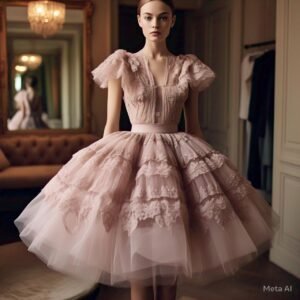
1946 fashion trends
Feminine Silhouettes Take Center Stage
1946 fashion trends marked the return of soft, flowing lines that accentuated the female form. The heavily structured and boxy looks of wartime fashion were replaced by garments that celebrated curves. Dresses and skirts in 1946 became fuller, often extending outward in large, sweeping shapes, while waistlines were emphasized to create a more defined, hourglass silhouette.
Women embraced soft fabrics like silk, satin, and wool, which allowed for a more fluid and feminine appearance. This emphasis on feminine shapes wasn’t limited to dresses and skirts—tailored suits also featured curves and waist-defining cuts that gave women a refined and sophisticated look. The 1946 fashion trends were all about celebrating womanhood and presenting an image of grace and elegance.
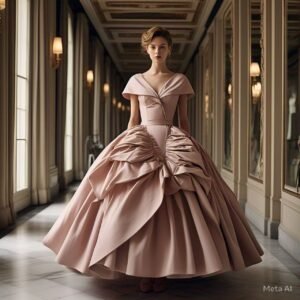
Suits with Skirts: The Power of Tailored Ensembles
Another key element of 1946 fashion trends was the popularity of tailored suits with skirts. As women began to return to the workforce after the war, there was an increased demand for sophisticated, yet comfortable, attire that could be worn both at work and in social settings. Suits in 1946 often featured a fitted jacket with narrow shoulders and a waist-defining cut, paired with either a pencil skirt or a full skirt that extended to mid-calf or ankle-length.
The tailored suits of 1946 emphasized a combination of power and femininity, with sharp lines that communicated professionalism and elegance. These suits were often worn with accessories such as gloves, hats, and scarves, which completed the polished look. By incorporating these elements, 1946 fashion trends showcased a blend of practicality and style that resonated with women of all social standings.

Luxurious Fabrics and Rich Textures
In the post-war period, 1946 fashion trends brought a return to luxurious fabrics that had been scarce during the years of fabric rationing. Silk, velvet, wool, and satin became key materials for both everyday wear and special occasions. This shift to opulent textiles reflected society’s desire to move away from wartime austerity and embrace an era of sophistication and luxury.
Dresses, suits, and accessories were often made from these rich fabrics, which helped to enhance the overall silhouette. Velvet, for instance, was commonly used for evening gowns, while wool was a popular choice for daywear and outerwear. The return of these sumptuous textiles also allowed designers to create intricate designs and textures, giving fashion a sense of depth and interest that was absent during the war years.
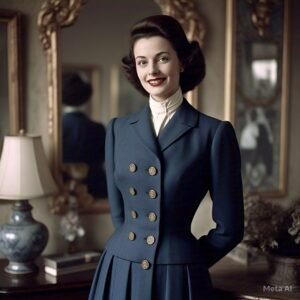
The Pin-Up Girl Influence on Fashion
The 1946 fashion trends also embraced the playful and seductive charm of the pin-up girl. With the end of the war, there was a surge in the popularity of pin-up art, which depicted women in glamorous, yet accessible, poses. These images were widely circulated in magazines, posters, and advertisements, influencing fashion and culture significantly.
Pin-up girls were often seen wearing form-fitting dresses, high heels, and hairstyles with soft waves or rolls. The style was feminine, alluring, and optimistic, reflecting the overall mood of the era. This influence was seen in everyday fashion as well, with dresses and separates designed to hug the body and highlight a woman’s curves. The pin-up style was an integral part of 1946 fashion trends and played a significant role in shaping the way women dressed in the post-war years.
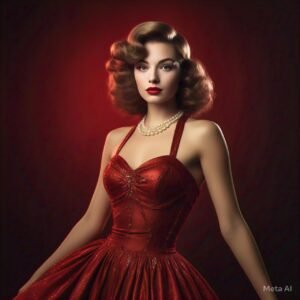
Bold Colors and Playful Patterns
1946 fashion trends were also marked by a resurgence of color. After years of muted tones due to fabric shortages, fashion in 1946 embraced a brighter palette of colors, including vibrant reds, blues, and pastel shades. These colors were used in everything from dresses and blouses to accessories like handbags and shoes, creating an atmosphere of fun and joy.
Patterns also became more prominent during this time, with florals, polka dots, and stripes making their way into both casual and formal outfits. These playful patterns were used to inject energy and optimism into fashion, a stark contrast to the somber styles of the wartime years. Whether in a polka-dot dress or a floral blouse, the bold use of color and pattern became a key aspect of the 1946 fashion trends.
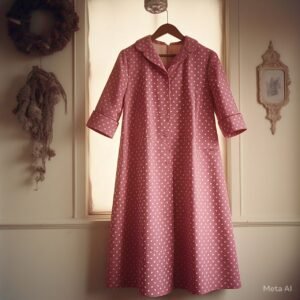
Accessories: The Finishing Touches
Accessories were an essential part of 1946 fashion trends. They added elegance, sophistication, and flair to any outfit, and were a way for women to express their personal style. Gloves, hats, scarves, and handbags were considered necessary accessories for a well-dressed woman.
Gloves, often made of soft leather or satin, were worn for formal occasions and daywear alike. Hats were also a significant trend in 1946, with wide-brimmed designs and small, elegant caps being popular choices. Scarves were often draped over the shoulders or tied around the neck to add a touch of sophistication. Handbags, frequently small and structured, completed the polished look. Accessories in 1946 were not merely functional—they were an integral part of a woman’s overall appearance and played a crucial role in defining the fashion of the era.

Conclusion: The Enduring Legacy of 1946 Fashion Trends
The 1946 fashion trends marked a pivotal moment in the history of style. After years of war and austerity, fashion embraced femininity, luxury, and optimism. From Christian Dior’s “New Look” to the playful influence of pin-up girls, 1946 fashion set the stage for the glamorous and sophisticated styles of the late 1940s and beyond. The emphasis on luxurious fabrics, structured silhouettes, and bold colors shaped the look of the post-war era and continues to inspire designers and fashion enthusiasts today.
As we look back at 1946, we see how fashion served as a symbol of hope and renewal, helping society transition from the hardships of war to a world filled with beauty, elegance, and possibility.

